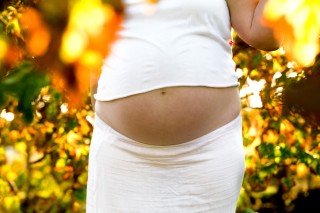- Dettagli
- Categoria: Women views on news
- Pubblicato: 28 Febbraio 2014
 New projects challenge manufactured images of womanly perfection.
New projects challenge manufactured images of womanly perfection.
Photographers, cancer survivors and mothers are producing a growing library of images cataloguing the visual effects of life on women’s bodies.
The images are often confrontational, with subjects looking directly at the camera and viewer.
The challenge to viewers and societies is explicit because the images purposely do not fit within the ‘sexy’ genre that has become the predominant way of visually portraying women in public.
Beth Whaanga, a nurse in Australia, decided to post photographs of her post-breast cancer body on Facebook in November 2013.
Diagnosed with breast cancer on her 32nd birthday, and as a carrier of the BRCA2 gene, the genetic mutation that carries increased risk for breast and ovarian cancer, Whaanga decided to undergo a double mastectomy, a hysterectomy, lymphadenectomy and melanoma lumpectomies.
As part of her recovery, Whaagna teamed up with her friend, photographer Nadia Masot, to create the Under the Red Dress project.
‘Your scars aren’t ugly. They mean you’re alive,’ she says on the project’s website.
When she posted the photographs of her post-surgery body, she said of the project, ‘The aim is to raise awareness for breast cancer. Each day we walk past people. These individuals appear normal but under their clothing sometimes their bodies tell a different story.’
The reaction to her posts was immediate: more than 100 people ‘de-friended’ her on the site, and several also reported the images as a violation of the site’s photo policy.
Facebook assured Whaanga that the company would not remove the images, and she received far more positive messages than negative.
Talking about the project, she said that those of us who find ourselves physically scarred by life’s events could easily slip into this idea that we were not beautiful at all.
‘What is beauty anyway?’ she then asked: ‘Let’s redefine’.
‘In this way we hope to enable people to appreciate just what negative messages they are unwittingly accepting without filter or accountability and at the same time bring awareness to the issue.’
Similarly, photographer David Jay’s The SCAR Project’s ‘mission is three-fold: to raise public consciousness of early-onset breast cancer, to raise funds for breast cancer research/outreach programmes and to help young survivors see their scars, faces, figures and experiences through a new, honest and ultimately empowering lens.
SCAR stands for Surviving Cancer. Absolute Reality and the sub-heading to the project is ‘Breast Cancer Is Not a Pink Ribbon.’
Both Jay and Masot did or do work in the fashion industry, and both projects could be seen as an antidote to the pink-focused aspect of many breast cancer campaigns.
Also challenging the hyper-sexualised public imagery of women are several mother and breastfeeding websites and projects, including the Shape of a Mother blog and Jade Beall’s Beautiful Body project.
The Shape of a Mother blog says that ‘a post-pregnancy body is one of this society’s greatest secrets; all we see of the female body is that which is airbrushed and perfect, and if we look any different, we hide it from the light of day in fear of being seen… [which mocks] the beauty that created and nourished our children.’
Photographer Jade Beall started the Beautiful Body Project in 2012 after becoming a mother and photographing her post-birth body.
She says on the project’s website, that the ‘ Beautiful Body project is a movement of women coming together to tell their stories and celebrate their ever-changing bodies so that future generations of women can live free from self-suffering.’
The project has grown from a celebration of motherhood and breastfeeding to encompass ‘beautiful women facing ageing, beautiful women dealing with cancer, beautiful young women facing eating disorders’ and more.
Beall gathers her photographs into books, and with volume one now in print, has a number of future volumes already planned.
Also contributing to a more realistic portrayal of women are a number of actresses who have chosen to be photographed without make-up or without digital re-touching for various magazines.
Recent examples are Kate Winslet and Scarlett Johansson in the 2014 Vanity Fair Hollywood edition, both of whom chose to appear make-up free.
Actresses are often known for their beauty as well as skill, so while not as challenging or forceful as some of the scar or post-pregnancy photographs, the images of the real person are still an important part of normalising imagery of women that is not super sexual or unrealistic.
Most projects of this type refer to the need to change the parameters of beauty for the benefit of younger women and girls, with the ideal situation being one in which women and girls are able to stop trying to force themselves into a narrow, manufactured ideal of unrealistic beauty.
Leggi tutto... http://feedproxy.google.com/~r/WomensViewsOnNews/~3/n6oRQt4v9Ps/








